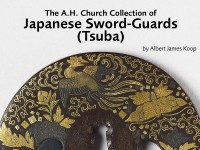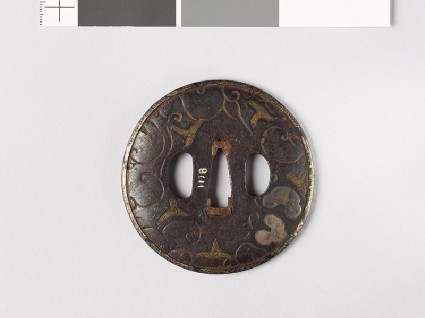The A. H. Church Collection of Japanese Sword-Guards (Tsuba)
An unpublished catalogue of the A. H. Church collection of Japanese sword-guards (tsuba) by Albert James Koop.

Publications online: 1264 objects
Tsuba with leaves and scrolling stems
-
Literature notes
Slightly cupped; pierced with two suhama ("sand-banks", three-lobed devices forming the badge of the Sanada), the piercings later filled with plain silver; the front coarsely engraved with a few scrolling stems, the smaller tendrils and five leaves being inlaid in brass. The hollow back has been red-lacquered during the 19th century (covering the silver plugs) and the three-sided rim added; this latter is in shakudō covered with exceedingly minute gold inlay in seven different designs (possibly by the inlayer of No. 1041 [EAX.11041], q.v., however). -
Details
- Associated place
- Date
-
forged 16th century (1501 - 1600)
lacquered 19th century (1801 - 1900)
- Material and technique
- obverse and reverse: iron, with engraved decoration, and hira-zōgan (flat inlay) in brass; piercings plugged with silver; shakudō rim, inlaid with gold; tang-hole plugged with soft metal, probably copper reverse: covered in red lacquer
- Dimensions
- 8 x 7.9 x 0.4 cm (height x width x depth)
- Material index
-
processed material › metal › iron,processed material › metal › alloy › copper alloy › brass,processed material › metal › alloy › copper alloy › shakudō,processed material › metal › gold,
- Technique index
- Object type index
-
arms/armour › koshirae › kodogu › tsuba
- No. of items
- 1
- Credit line
- Bequeathed by Sir Arthur H. Church, 1915.
- Accession no.
- EAX.10158
-
Further reading
Koop, Albert James, The A. H. Church Collection of Japanese Sword-Guards (Tsuba), 3 vols (Oxford, Ashmolean Museum, 1929), no. 158
Glossary (3)
lacquer, shakudō, tsuba
-
lacquer
Chinese and Japanese lacquer is made from the sap of the lacquer tree, which is indigenous to Eastern China. It is applied to wood as a varnish or for decorative effect. In India and the Middle East, lacquer is made from the deposit of the lac insect.
-
shakudō
alloy of copper and gold, patinated to a dark blue-black colour
-
tsuba
Japanese sword guard.
Location
-
- currently in research collection
Objects are sometimes moved to a different location. Our object location data is usually updated on a monthly basis. Contact the Jameel Study Centre if you are planning to visit the museum to see a particular object on display, or would like to arrange an appointment to see an object in our reserve collections.
Publications online
-

The A. H. Church Collection of Japanese Sword-Guards (Tsuba)
Slightly cupped; pierced with two suhama ("sand-banks", three-lobed devices forming the badge of the Sanada), the piercings later filled with plain silver; the front coarsely engraved with a few scrolling stems, the smaller tendrils and five leaves being inlaid in brass. The hollow back has been red-lacquered during the 19th century (covering the silver plugs) and the three-sided rim added; this latter is in shakudō covered with exceedingly minute gold inlay in seven different designs (possibly by the inlayer of No. 1041 [EAX.11041], q.v., however).
Notice
Object information may not accurately reflect the actual contents of the original publication, since our online objects contain current information held in our collections database. Click on 'buy this publication' to purchase printed versions of our online publications, where available, or contact the Jameel Study Centre to arrange access to books on our collections that are now out of print.
© 2013 University of Oxford - Ashmolean Museum

